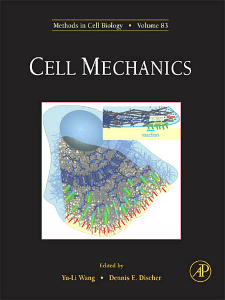Description
Cell Mechanics
Coordinators: Wang Yu-Li, Discher Dennis E.
Language: English
Subjects for Cell Mechanics:
Publication date: 09-2007
632 p. · 19x23.3 cm · Hardback
632 p. · 19x23.3 cm · Hardback
Description
/li>Contents
/li>Readership
/li>Comment
/li>
Cell mechanics is the field of study that looks at how cells detect, modify, and respond to the physical properties of the cell environment. Cells communicate with each other through chemical and physical signals which are involved in a range of process from embryogenesis and wound healing to pathological conditions such as cancerous invasion. Similar principles are also likely to be critical for success in regenerative medicine. Cell mechanics is thus central to understanding these principles. As cell mechanics draws from the fields of biology, chemistry, physics, engineering, and mathematics, this book aims not only to provide a collection of research methods, but also to develop a common language among scientists who share the interest in cell mechanics but enter the field with diverse backgrounds. To this end all of the contributing authors have sought to explain in plain language the nature of the biological problems, the rationale for the approaches, in addition to the methods themselves. In addition, to balance practical utility against conceptual advances, Cell Mechanics has intentionally included both chapters that provide detailed recipes and those that emphasize basic principles.
I. Basics Concept and Preparation of Culture Substrates for Cell Mechanical Studies.
Basic Rheology for Biologists.
Polyacrylamide Hydrogels for Cell Mechanics: Steps towards Optimization and Alternative Uses.
Microscopic Methods for Measuring the Elasticity of Gel Substrates for Cell Culture: Microspheres, Microindenters, and Atomic Force Microscopy.
Surface Patterning.
Molecular Engineering of Cellular Environments: Cell Adhesion to Nano-Digital Surfaces.
II. Subcellular Mechanical Properties and Activities.
Probing Cellular Mechanical Responses to Stimuli Using Ballistic Intracellular Nanorheology.
Multiple Particle Tracking and Two-Point Microrheology in Cells.
Imaging Stress Propagation in the Cytoplasm of a Living Cell.
Probing Intracellular Force Distributions by High-Resolution Live Cell Imaging and Inverse Dynamics.
Analysis of Microtubule Curvature.
Nuclear Mechanics and Methods.
III. Cellular and Embryonic Mechanical Properties and Activities.
The Use of Gelatin Substrates for Traction Force Microscopy in Rapidly Moving Cells.
Microfabricated Silicone Elastomeric Post Arrays for Measuring Traction Forces of Adherent Cells.
Cell Adhesion Strengthening: Measurement and Analysis.
Studying the Mechanics of Cellular Processes by Atomic Force Microscopy.
Using Force to Probe Single-Molecule Receptor-Cytoskeletal Anchoring beneath the Surface of a Living Cell.
High Throughput Rheological Measurements with an Optical Stretcher.
Measuring Mechanical Properties of Embryos and Embryonic Tissues.
IV. Mechanical Stimuli to Cells.
Tools to Study Cell Mechanics and Mechanotransduction.
Magnetic Tweezers in Cell Biology.
Optical Neuronal Guidance.
Microtissue Elasticity: Measurements by Atomic Force Microscopy and Its Influence on Cell Differentiation.
Demystifying the effects of a three-dimensional microenvironment in tissue morphogenesis.
Basic Rheology for Biologists.
Polyacrylamide Hydrogels for Cell Mechanics: Steps towards Optimization and Alternative Uses.
Microscopic Methods for Measuring the Elasticity of Gel Substrates for Cell Culture: Microspheres, Microindenters, and Atomic Force Microscopy.
Surface Patterning.
Molecular Engineering of Cellular Environments: Cell Adhesion to Nano-Digital Surfaces.
II. Subcellular Mechanical Properties and Activities.
Probing Cellular Mechanical Responses to Stimuli Using Ballistic Intracellular Nanorheology.
Multiple Particle Tracking and Two-Point Microrheology in Cells.
Imaging Stress Propagation in the Cytoplasm of a Living Cell.
Probing Intracellular Force Distributions by High-Resolution Live Cell Imaging and Inverse Dynamics.
Analysis of Microtubule Curvature.
Nuclear Mechanics and Methods.
III. Cellular and Embryonic Mechanical Properties and Activities.
The Use of Gelatin Substrates for Traction Force Microscopy in Rapidly Moving Cells.
Microfabricated Silicone Elastomeric Post Arrays for Measuring Traction Forces of Adherent Cells.
Cell Adhesion Strengthening: Measurement and Analysis.
Studying the Mechanics of Cellular Processes by Atomic Force Microscopy.
Using Force to Probe Single-Molecule Receptor-Cytoskeletal Anchoring beneath the Surface of a Living Cell.
High Throughput Rheological Measurements with an Optical Stretcher.
Measuring Mechanical Properties of Embryos and Embryonic Tissues.
IV. Mechanical Stimuli to Cells.
Tools to Study Cell Mechanics and Mechanotransduction.
Magnetic Tweezers in Cell Biology.
Optical Neuronal Guidance.
Microtissue Elasticity: Measurements by Atomic Force Microscopy and Its Influence on Cell Differentiation.
Demystifying the effects of a three-dimensional microenvironment in tissue morphogenesis.
Cell biologists, neurobiologists, tissue engineers, translational biologists in fields of cancer, cardiovascular medicine, orthopedic medicine. Physicists and mechanical engineers interested in entering biomedical research.
- Presents a distinctive emphasis on matrix mechanics and their interplay with cell functions
- Includes highly significant topics relevant to basic and translational research, as well as tissue engineering
- Emphasizes mechanical input and output of cells
© 2024 LAVOISIER S.A.S.
These books may interest you

Plant Cell Biology 170.55 €

Principles of Regenerative Medicine 193.44 €


